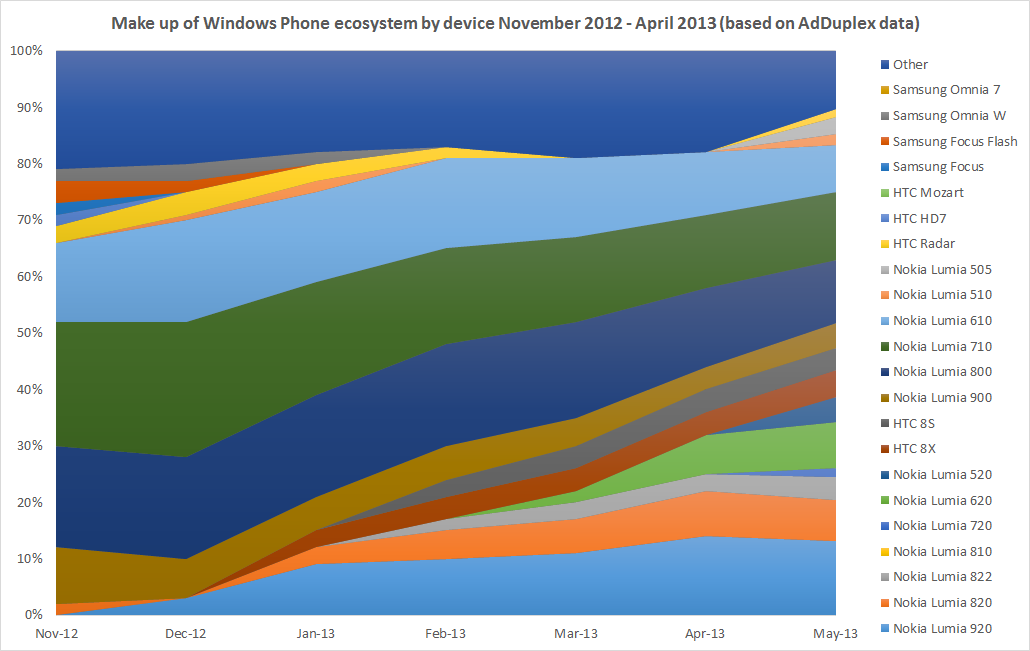The data for the global device breakdown shows that Nokia continues to be dominant, taking all six of the top device slots, and eight of the top ten. The Nokia Lumia 920 remains the most common device, but notable climbers include the Nokia Lumia 620, up to fifth with 8.1%, and the Nokia Lumia 520 taking eigth place with 4.4% in its very first month of sales.
Also notable is the presence of the Nokia Lumia 505 at 3%. The device, which is effectively an operator requested variant of the Lumia 510, is only available in a handful of markets, but shows how a device can do well if it is given significant backing by a major operator. The Nokia Lumia 822, Verizon exclusive device, which makes up 4% of active Windows Phone devices, is another example of this.
It's worth emphasising that AdDuplex can only track devices where an app with its advertising SDK embedded is being actively used. This means high end devices, such as the Lumia 920 and HTC 8X, tend to be over represented in such data sets because owners of these devices are more likely to install apps.

Image Source: AdDuplex
AdDuplex also provides device breakdown data for a number of other countries, which we have collated into a table below. With a few notable exceptions (HTC 8S in Poland, Russia, and the UK; and HTC 8X in USA) all the dominant devices are from Nokia.
The country level data also clearly shows the rise of lower cost devices. The standout example are the Nokia Lumia 505 in Mexico, which makes up one third of all active Windows Phone devices, and the Nokia Lumia 520 in India, which represents 16.9% of all devices, despite having only been on sale for three weeks.
Each market is different, with some seeing higher end devices in the majority (e.g. the US), some having a higher proportion of lower end devices (e.g. Poland and India), and some in between the two (e.g. UK and Russia). Some of these differences are due to country-level economics, but the relative strength of operators and subsidy levels are also important.

AdDuplex has now been reporting data for seven months, which let us see the changing nature of active devices in the Windows Phone ecosystem over time. The most obvious changes occur when new devices go on sale, with this month seeing the debut of the Nokia Lumia 520 and 720. The rapid rise of both the Nokia Lumia 520 and 620 underline the importance of Microsoft and Nokia's low cost device strategy.
In less than month of sales the Nokia Lumia 520 has sold almost as many devices at the HTC 8X (on sale for six months). Similarly the Nokia Lumia 620 and 820 have similar figures in the AdDuplex data, suggesting roughly the same number of each device has been sold, despite the Nokia Lumia 820 being available for twice as long as the Lumia 620.

Breaking the devices down into Windows Phone 7 and Windows Phone 8 groupings we can see the increasing volume of Windows Phone 8 devices in the active installed based over time. As of May 3rd AdDuplex reports that Windows Phone 8 make up just under 50% of active devices. Given that it's now May 7th the crossover point has now almost certainly been reach and there are now more active Windows Phone 8 devices than active Windows Phone 7 devices.
That this crossover point has happened just six months after the official launch of Windows Phone 8 is indicative of the strong growth in sales of Windows Phone devices. Ignoring non-active devices (of which there will be some) it means that as many Windows Phone 8 devices have been sold in six months as Windows Phone 7 devices in the preceeding 30 months.

You can read the full report on the AdDuplex blog.
